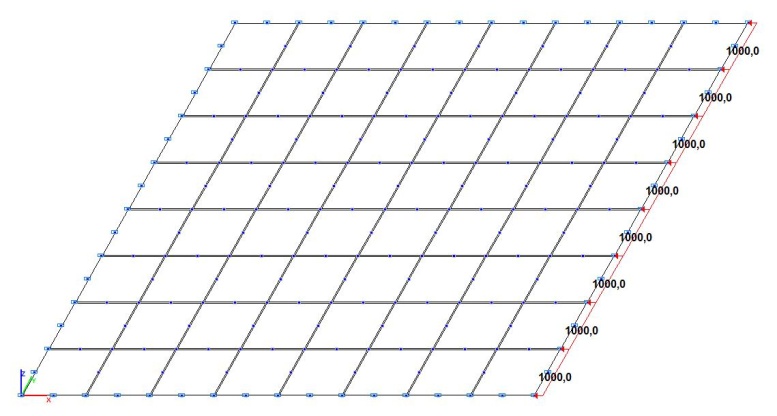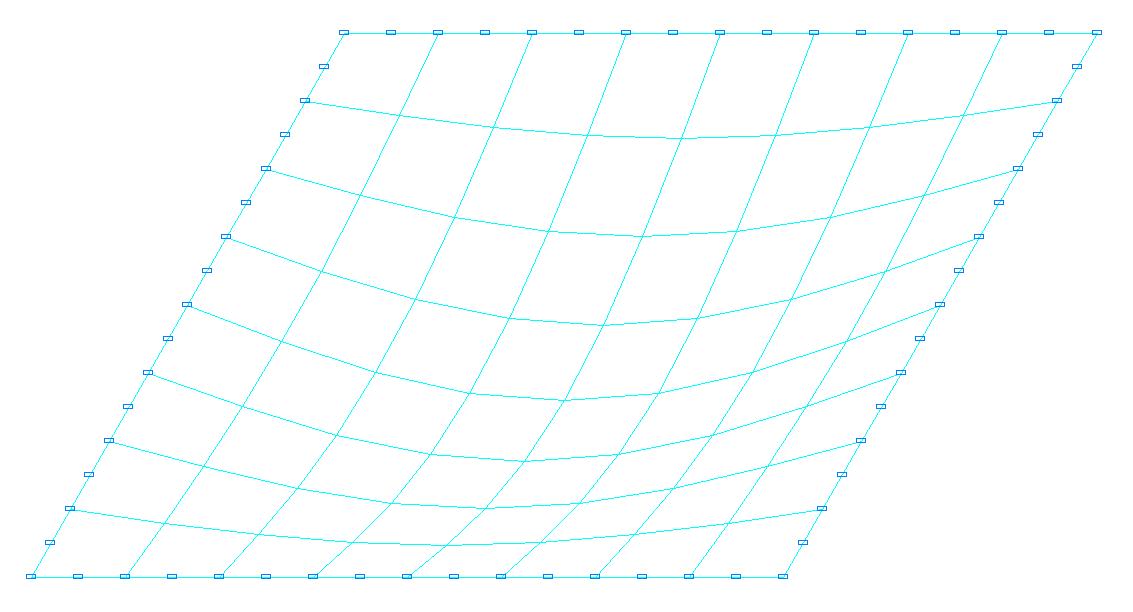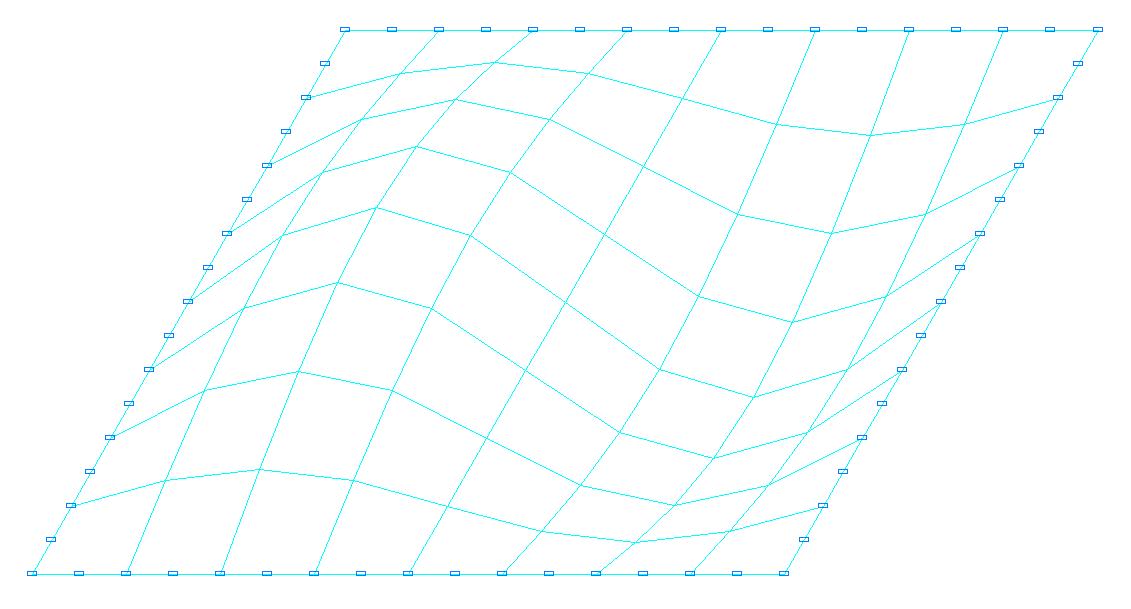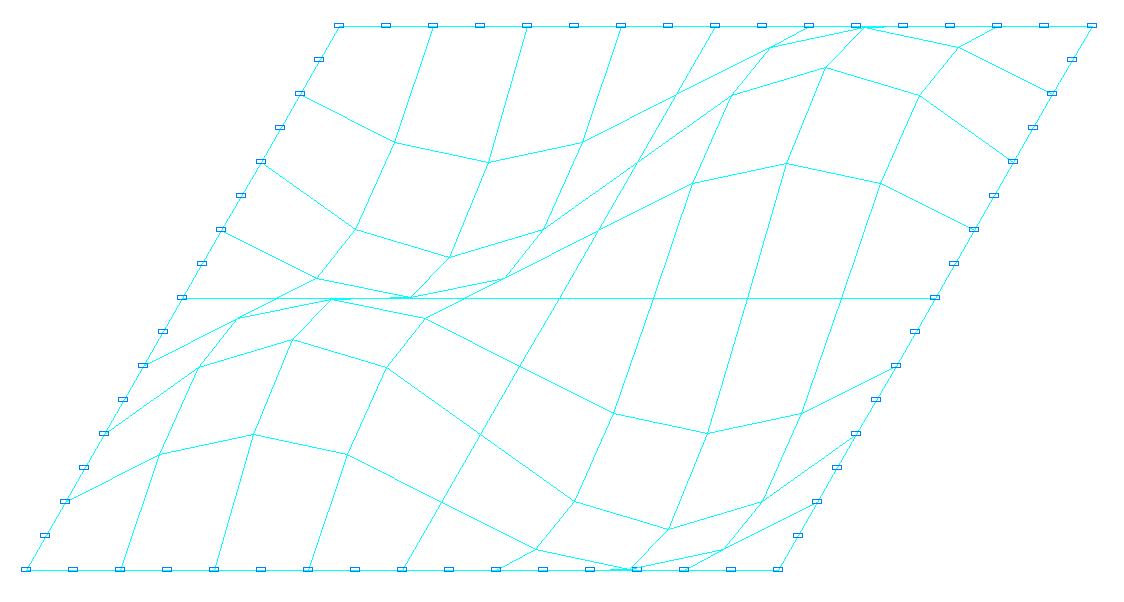Stability of a Rectangular Simply Supported Orthotropic Plate Uniformly Compressed in One Direction
Objective: Determination of the critical value of the compressive forces uniformly distributed along two opposite transverse sides of a rectangular simply supported orthotropic plate corresponding to the moment of its buckling.
Initial data files:
|
File name |
Description |
|---|---|
|
Design model with the ratios of the sides of the plate a/b = 1.0 |
|
|
Design model with the ratios of the sides of the plate a/b = 4.0 |
Problem formulation: The rectangular simply supported orthotropic plate is subjected to the action of compressive forces σ, uniformly distributed along two opposite transverse sides. Determine the critical value of the compressive forces σcrort, corresponding to the moment of buckling of the rectangular orthotropic plate.
References: A.S. Volmir. Stability of Deformable Systems, Moscow, Nauka, 1967, p. 374.
Initial data:
| a = 0.6; 2.4 m | - side of the rectangular plate free from forces (along the X axis of the global coordinate system); |
| b = 0.6 m | - side of the rectangular plate subjected to the compressive forces (along the Y axis of the global coordinate system); |
| h = 0.01 m | - thickness of the rectangular plate; |
| Ex = 5.600·108 kN/m2 | - elastic modulus of the plate material corresponding to longitudinal deformations along the X axis of the global coordinate system; |
| νyx = 0.300 | - Poisson’s ratio corresponding to transverse deformations along the Y axis of the global coordinate system; |
| Ey = 2.123·108 kN/m2 | - elastic modulus of the plate material corresponding to longitudinal deformations along the Y axis of the global coordinate system; |
| νxy = 0.114 | - Poisson’s ratio corresponding to transverse deformations along the X axis of the global coordinate system; |
| Gxy = 0.769·108 kN/m2 | - shear modulus of the plate material; |
| σ = 1.0·105 kN/m2 | - initial value of the compressive forces. |
Finite element model: Design model – general type system. Two design models with the ratios of the sides of the plate a/b = 1.0; 4.0 are considered. The plate is modeled by eight-node shell elements of type 50. The spacing of the finite element mesh along the sides of the plate (along the X and Y axes of the global coordinate system) is 0.075 m. Number of plate elements in the models – 64; 256. Boundary conditions are provided by imposing constraints on the nodes of the support contour of the plate in the direction of the degree of freedom Z. A load uniformly distributed along the line with the initial value p = σ∙h = 1000 kN/m is specified on one of the two opposite sides of the plate subjected to the compressive forces, and the constraints in the respective direction (along the X axis of the global coordinate system) are imposed on the nodes of the other one. The dimensional stability of the design model is provided by imposing constraints in the normal direction (along the Y axis of the global coordinate system) on the nodes of one of the two opposite sides of the plate free from forces, and by imposing a constraint in the UZ direction of the global coordinate system on the node of one of the corners of the plate. The dimensional stability of the design model is provided by imposing constraints in the normal direction (along the Y axis of the global coordinate system) on the nodes of one of the two opposite longitudinal sides of the plate free from forces, and by imposing a constraint in the UZ direction of the global coordinate system on the node of one of the corners of the plate. Number of nodes in the models – 225; 849.
Results in SCAD

Design model with the ratio of the sides of the plate a/b = 1.0

Design model with the ratio of the sides of the plate a/b = 4.0

1-st buckling mode for the design model with the ratio of the sides of the plate a/b = 1.0

2-nd buckling mode for the design model with the ratio of the sides of the plate a/b = 1.0

3-rd buckling mode for the design model with the ratio of the sides of the plate a/b = 1.0

1-st buckling mode for the design model with the ratio of the sides of the plate a/b = 4.0

2-nd buckling mode for the design model with the ratio of the sides of the plate a/b = 4.0

3-rd buckling mode for the design model with the ratio of the sides of the plate a/b = 4.0
Comparison of solutions:
Critical value of the compressive forces σcrort, kN/m2
|
Plate sides ratio |
Buckling mode |
Number of half waves in the transverse n and in the longitudinal m directions |
Theory |
SCAD |
Deviation, % |
|---|---|---|---|---|---|
|
a/b = 1.0 |
1 |
1; 1 |
283093 |
2.831349 ∙1000/0.01 = = 283135 |
0.01 |
|
2 |
1; 2 |
642810 |
6.428985 ∙1000/0.01 = = 642899 |
0.01 |
|
|
3 |
2; 2 |
1132373 |
11.326625 ∙1000/0.01= = 1132663 |
0.03 |
|
|
a/b = 4.0 |
1 |
1; 3 |
264196 |
2.642394 ∙1000/0.01 = = 264239 |
0.02 |
|
2 |
1; 4 |
283093 |
2.831351 ∙1000/0.01 = = 283135 |
0.01 |
|
|
3 |
1; 2 |
334385 |
3.344432 ∙1000/0.01 = = 334443 |
0.02 |
Notes: In the analytical solution the critical value of the compressive forces σcr, corresponding to the moment of buckling of the rectangular orthotropic plate can be determined according to the following formula:
\[\sigma_{crort} =\frac{\pi^{2}\cdot \sqrt {D_{1} \cdot D_{2} } }{b^{2}\cdot h}\cdot \left[ {\sqrt {\frac{D_{1} }{D_{2} }} \cdot \left( {\frac{m\cdot b}{a}} \right)^{2}+\frac{2\cdot D_{3} \cdot n^{2}}{\sqrt {D_{1} \cdot D_{2} } }+\sqrt {\frac{D_{2} }{D_{1} }} \cdot \left( {\frac{n^{2}\cdot a}{m\cdot b}} \right)^{2}} \right], \quad where: \] \[ D_{1} =\frac{E_{x} \cdot h^{3}}{12\cdot \left( {1-\nu_{yx} \cdot \nu_{xy} } \right)}, \quad D_{2} =\frac{E_{y} \cdot h^{3}}{12\cdot \left( {1-\nu_{yx} \cdot \nu_{xy} } \right)}, \] \[ D_{3} =\frac{1}{2}\cdot \left( {D_{1} \cdot \nu_{xy} +D_{2} \cdot \nu_{yx} +4\cdot D_{t} } \right), \quad D_{t} =\frac{G_{xy} \cdot h^{3}}{12}, \]
n, m = 1, 2, 3 … – number of half waves of the buckling mode in the transverse and longitudinal directions with respect to the compression of the plate.
Stiffness properties of the orthotropic plate were taken on the basis of the conditions of equivalence to the stiffness properties of the reinforced plate from the Example 6.10 a:
\[ D_{1} =\frac{E\cdot I}{\frac{b}{s+1}}+\frac{E\cdot h^{3}}{12\cdot \left( {1-\nu^{2}} \right)}, \quad D_{2} =\frac{E\cdot h^{3}}{12\cdot \left( {1-\nu^{2}} \right)}, \quad D_{3} =\frac{E\cdot h^{3}}{12\cdot \left( {1-\nu^{2}} \right)}, \]
and were determined according to the following formulas:
\[ E_{x} =\frac{E}{1-\nu^{2}}\cdot \left[ {\frac{12\cdot \left( {1-\nu^{2}} \right)\cdot I}{h^{3}\cdot \frac{b}{s+1}}+1} \right]\cdot \left[ {1-\frac{\nu^{2}}{\frac{12\cdot \left( {1-\nu^{2}} \right)\cdot I}{h^{3}\cdot \frac{b}{s+1}}+1}} \right], \quad E_{y} =\frac{E}{1-\nu^{2}}\cdot \left[ {1-\frac{\nu^{2}}{\frac{12\cdot \left( {1-\nu^{2}} \right)\cdot I}{h^{3}\cdot \frac{b}{s+1}}+1}} \right], \] \[ \nu_{yx} =\nu , \quad \nu_{xy} =\frac{\nu }{\frac{12\cdot \left( {1-\nu^{2}} \right)\cdot I}{h^{3}\cdot \frac{b}{s+1}}+1}, \quad G_{xy} =\frac{E}{2\cdot \left( {1+\nu } \right)}. \]
The critical values of the compressive forces σcr for the reinforced plate have to be reduced by a factor k with respect to the critical values of the compressive forces σcr for the orthotropic plate, because when determining the latter the component acting on the stiffeners of the reinforced plate is not taken into account:
\[ k=\frac{b\cdot h}{b\cdot h+F\cdot s}=0.869565, \]
where F is stiffener’s area, s is the quantity of stiffeners.
Critical value of the compressive forces σcr, kN/m2
|
Plate sides ratio |
Buckling mode |
Number of half waves in the transverse n and in the longitudinal m directions |
Theory |
SCAD |
Deviation, % |
|---|---|---|---|---|---|
|
a/b = 1.0 |
1 |
1; 1 |
235900 |
283135∙0.869565 = = 246204 |
4.37 |
|
2 |
1; 2 |
533934 |
642899∙0.869565 = = 559043 |
4.70 |
|
|
3 |
2; 2 |
942681 |
1132663∙0.869565 = = 984924 |
4.48 |
|
|
a/b = 4.0 |
1 |
1; 3 |
220165 |
264239∙0.869565 = = 229773 |
4.36 |
|
2 |
1; 4 |
235900 |
283135∙0.869565 = = 246204 |
4.37 |
|
|
3 |
1; 2 |
278652 |
334443∙0.869565 = = 290820 |
4.37 |